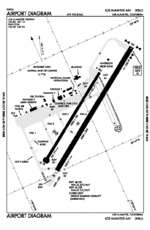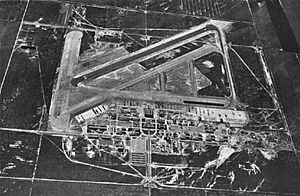Los Alamitos Army Airfield facts for kids
Quick facts for kids
Los Alamitos AAF
|
|||||||||||||||
|---|---|---|---|---|---|---|---|---|---|---|---|---|---|---|---|

FAA airport diagram
|
|||||||||||||||
| Summary | |||||||||||||||
| Airport type | Military | ||||||||||||||
| Operator | United States Army | ||||||||||||||
| Location | Los Alamitos, California | ||||||||||||||
| Elevation AMSL | 35 ft / 11 m | ||||||||||||||
| Coordinates | 33°47′24″N 118°03′05″W / 33.79000°N 118.05139°W | ||||||||||||||
| Runway | |||||||||||||||
|
|||||||||||||||
|
Sources: Official website and FAA
|
|||||||||||||||
Los Alamitos Army Airfield (ICAO: KSLI, FAA LID: SLI) is a special military airport located in Los Alamitos, California. It's about one mile (2 km) southeast of the city center. This airfield plays an important role in supporting military operations and training in the region.
Contents
What are the Runways at Los Alamitos?
Los Alamitos Army Airfield has two main runways for planes to take off and land. These runways are designed to handle different types of aircraft.
- Runway 4L/22R: This runway is 5,900 feet long and 150 feet wide (about 1,798 meters long and 46 meters wide). Its surface is made of PEM (Porous European Mix).
- Runway 4R/22L: This runway is longer, at 8,000 feet long and 200 feet wide (about 2,438 meters long and 61 meters wide). It has a surface made of both Asphalt and Concrete.
A Brief History of Los Alamitos Airfield
The story of Los Alamitos Army Airfield began in the 1930s. Back then, the United States Navy used parts of the Long Beach Airport for its training.
The Navy faced some challenges with the city of Long Beach regarding improvements and upkeep of the airport. Navy leaders, like Admiral Ernest J. King, asked the city to fix the runways. They reminded the city that the Navy's ships in the nearby harbors brought a lot of money to the area. Eventually, the city made the repairs.
However, the city of Long Beach was still not keen on letting the Navy lease more land for its needs. The Navy decided it was time to find a new, permanent home for its flight operations.
The Navy found a good piece of land owned by Susanna Bixby Bryant. The base commander, Commander Thomas A. Gray, shared this discovery with Admiral John H. Towers. The Navy's leaders, including James V. Forrestal, approved the purchase. Mrs. Bryant was very patriotic and sold her land at a lower price than offered, helping the Navy get its new base. This land was about 4 miles east of the Long Beach Airport.
In 1941, after the land was bought, money was quickly approved to start building. The new Naval Reserve Air Base (NRAB) Los Alamitos began to take shape. This project created many jobs and helped the local area grow. On June 1, 1941, all flight operations officially moved from Long Beach to the new Los Alamitos base.
By May 1942, the base was fully operational. It had offices, a medical area, training facilities, classrooms, and a repair department. About 2,500 officers and men were stationed there, and new aviation cadets began their training. The first class had 729 cadets graduate. By the end of that year, the base had grown from 36 planes to 140. In 1943, five more smaller airfields were added for training.
On August 15, 1943, the base was renamed a naval air station. It became a key place for training fleet units and servicing aircraft from Navy ships, including carrier air groups from famous ships like the USS Lexington and USS Saratoga. By January 1945, the total investment in the station was over $4.8 million, making it one of the Navy's most important air stations.
Los Alamitos After World War II
After the war, many military personnel decided to stay in Los Alamitos. Some neighborhoods even have streets named after World War II aircraft carriers, like Carrier Row.
The base continued to change and adapt after the war. Its main jobs were to train reserve pilots and service the Navy's fleet. By the end of 1946, Los Alamitos was one of the busiest Naval Air Reserve Stations in the country, with many reserve pilots and active-duty staff.
In 1947, the administration of another Navy airfield, NAF Litchfield Park in Arizona, was placed under Los Alamitos. This helped serve reserve aviation personnel in the Phoenix and Tucson areas. Los Alamitos remained the largest Naval Air Reserve Station in the United States.
New Aircraft and Training in the 1950s
On November 7, 1949, Los Alamitos welcomed its first jet aircraft, an FJ-1 Fury. The base continued to train pilots and ground officers. When the Korean War began, many reservists from Los Alamitos volunteered for duty, showing their dedication. The base also helped save lives and property during floods in the nearby town of Los Alamitos in 1951. In 1952, the first helicopter unit arrived at the base.
John Glenn's Record Flight
On July 16, 1957, Major John Glenn, who would later become a famous astronaut, set a new Transcontinental air speed record. He flew an F8U-1 Crusader jet from NAS Los Alamitos to Floyd Bennett Field in New York in just 3 hours, 23 minutes, and 8.4 seconds. This flight, called "Project Bullet," was the first time a plane flew across the United States at supersonic speed. It also created the first continuous panoramic photograph of the country. Glenn received his fifth Distinguished Flying Cross for this amazing achievement.
Changes in Command and Purpose
Operations at Los Alamitos continued as usual for about ten years. In 1970, the Navy changed the station's role, making it a Naval Air Station rather than a primary training facility.
In 1972, helicopter units from the California Army National Guard and United States Army Reserve moved to NAS Los Alamitos. After some planning, the base was officially named an Armed Forces Reserve Center. The Navy was the host, but the California Army National Guard was put in charge of running the airfield.
On August 23, 1977, the base was officially transferred from the U.S. Navy to the U.S. Army. The Army then allowed the California Army National Guard to operate it. The senior command on post is the 40th Infantry Division (Mechanized).
In July 2000, Los Alamitos Armed Force Reserve Center was renamed the Los Alamitos Joint Forces Training Center. This name reflects its role in training different branches of the military.
The base has even appeared on TV! It was the starting line for the 14th season of the reality show The Amazing Race. Its status as an alternate landing area for Air Force One was also mentioned in an episode of the TV show The West Wing.
- FAA Airport Diagram (PDF), effective 15 December 2011
Images for kids
-
McDonnell Douglas F-4 Phantom IIs of VF-22L1 at JFTB, 1970





